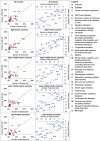Economic Evaluation in Global Perspective: A Bibliometric Analysis of the Recent Literature
- PMID: 26804359
- PMCID: PMC5042080
- DOI: 10.1002/hec.3305
Economic Evaluation in Global Perspective: A Bibliometric Analysis of the Recent Literature
Abstract
We present a bibliometric analysis of recently published full economic evaluations of health interventions and reflect critically on the implications of our findings for this growing field. We created a database drawing on 14 health, economic, and/or general literature databases for articles published between 1 January 2012 and 3 May 2014 and identified 2844 economic evaluations meeting our criteria. We present findings regarding the sensitivity, specificity, and added value of searches in the different databases. We examine the distribution of publications between countries, regions, and health areas studied and compare the relative volume of research with disease burden. We analyse authors' country and institutional affiliations, journals and journal type, language, and type of economic evaluation conducted. More than 1200 economic evaluations were published annually, of which 4% addressed low-income countries, 4% lower-middle-income countries, 14% upper-middle-income countries, and 83% high-income countries. Across country income levels, 53, 54, 86, and 100% of articles, respectively, included an author based in a country within the income level studied. Biomedical journals published 74% of economic evaluations. The volume of research across health areas correlates more closely with disease burden in high-income than in low-income and middle-income countries. Our findings provide an empirical basis for further study on methods, research prioritization, and capacity development in health economic evaluation.
Keywords: bibliometrics; cost-effectiveness analysis; economic evaluation; high-income countries; low-income countries; middle-income countries.
© 2016 The Authors. Health Economics published by John Wiley & Sons Ltd.
Figures




References
-
- Aksnes DW, Schneider JW, Gunnarsson M. 2012. Ranking national research systems by citation indicators: a comparative analysis using whole and fractionalised counting methods. Journal of Informetrics 6: 36–43.
-
- Augustovski F, Iglesias C, Manca A, Drummond M, Rubinstein A, Marti SG. 2009. Barriers to generalizability of health economic evaluations in Latin America and the Caribbean region. PharmacoEconomics 27: 919–29. - PubMed
-
- Bartram J, Lewis K, Lenton R, Wright A. 2005. Focusing on improved water and sanitation for health. Lancet 365: 810–2. - PubMed
-
- Chao TE, Sharma K, Mandigo M, Hagander L, Resch SC, Weiser TG, Meara JG. 2014. Cost‐effectiveness of surgery and its policy implications for global health: a systematic review and analysis. The Lancet Global Health 2: e334–e345. - PubMed
Publication types
MeSH terms
LinkOut - more resources
Full Text Sources
Other Literature Sources
Molecular Biology Databases

